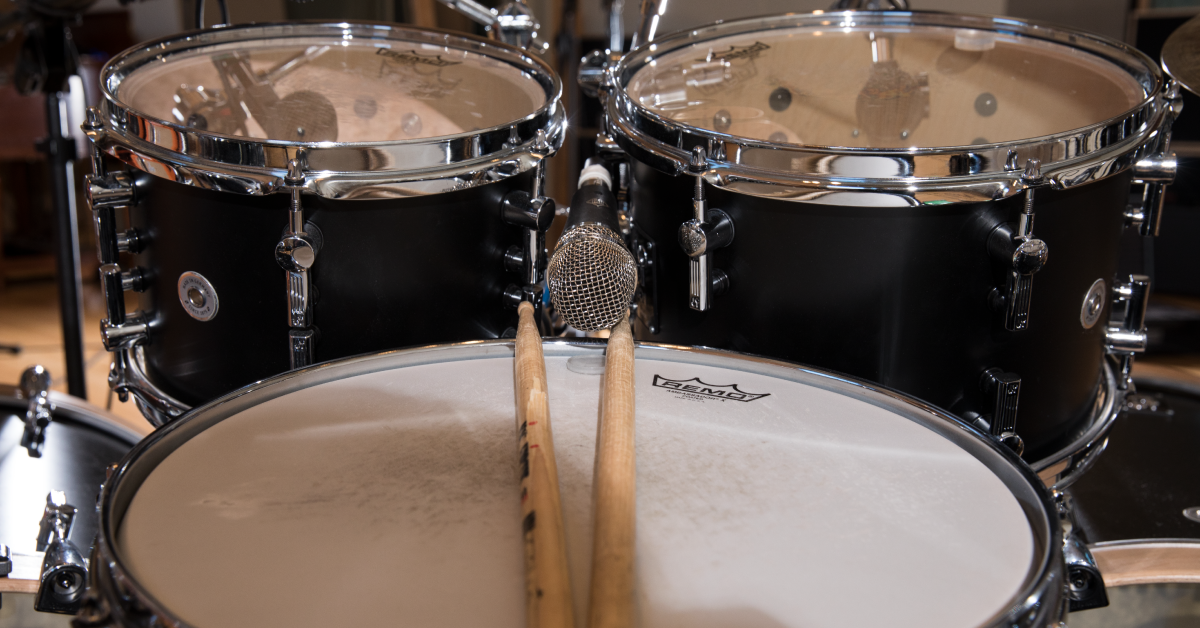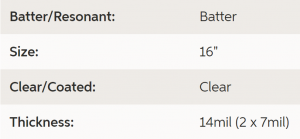How Long Do Drumheads Last?

If you constantly have to change your drumheads because they tear or sound dead, you’re in the right place! Having to swap out heads frequently can undoubtedly become a very daunting (and expensive) task.
Drumheads take a literal beating and will need to be replaced at one point or another. There’s no way around that. There are quite a few things that can certainly shorten your drumhead’s lifespan, however, such as technique, tuning, material, and even the type of stick you use! With all of that being said, continue below to learn more about how often you should change your drumheads and learn how to extend their lives.
- How often should you replace drumheads
- Should I replace my resonant drumheads?
- How long do drumheads last?
How often should you replace drumheads?
TIP: No matter how long you like to keep your drumheads on, it’s always good to have backups available. If a head breaks in the middle of a show and you don’t have a spare, you may have to patch it up with tape or not use the drum at all, and that isn’t a pleasant experience.
One of the most (if not the most) frequently asked questions by drummers is, “How often should I replace my drumheads?” Well, you’ll get a different answer every time. A popular belief is that you should change all of your batter side drumheads approximately every six months or so. All of that being said, there are a few factors to consider when thinking about changing drumheads.
Dreamhead dents and tears
The most apparent reason it’s time to change your drumheads is that they’re covered in dents or starting to tear. There are a few things that can cause dents (you may hear the term pitting). The first factor is the drum’s angle. The more the drum faces you, the more susceptible you are to denting as more of the drum stick’s bead strikes the head.
Similarly, the less parallel the stick is striking the head, the more you’re likely to dent it. You’re essentially “stabbing” the head at that point. More surface area equals more projection. You want to play as comfortably as possible, but if you’re going through heads quickly, you may want to focus on adjusting your stick technique to find a good balance between comfort and longevity.
When it comes to tears in the heads, most will be very noticeable. However, if you don’t see any tears on the head’s playing surface but you’re having consistent tuning issues, check the head’s collar, as there could be a small tear there.
Drumhead tone
This is a highly debated subject among the drumming community, but there’s honestly no right or wrong answer when replacing heads once they lose tonal quality. Some say you need to replace batter side drumheads every six months, depending on how frequently you play, while others may say they swap theirs every four years, and they love the sound.
Some prefer a less resonant (very almost no resonance at all) tone, especially with Motown and other genres that lend themselves to a dry sound. Conversely, drummers that prefer more of a “bell-like” resonance often replace them much more frequently.
For example, John Densmore, drummer for The Doors, absolutely hated the sound of new heads and refused to replace them. In his words, he wanted “the drums to snarl because that was my sound.” At The End of the day, your drum’s tone is truly “in the ear of the beholder.”
- Replace your drumheads if there is pitting and/or tearing.
- Replace your drumheads if they don’t stay in tune. This usually means the drumheads are stretched to their limits.
- Bass drum batter side heads can be replaced much less often when using a bass drum patch.
- If you prefer a less resonant sound to your drums and the drumhead still holds its pitch, it’s unnecessary to replace them. However, if you prefer a more “bell-like” resonance and they sound muted (almost dead), no matter how much you tune, you’ll probably want to change your drumheads.
- If you swapped drumheads for a studio session but still want that “vintage” sound, use some type of muffling. T-shirts, towels, Moongels, and gaffer tape are popular to achieve that sound.
- Coated heads: When you can see through the coating, it’s probably time to change them (unless it’s personal preference). There are many reasons why some drummers prefer coated over clear, so if that coating wears off, it almost defeats the purpose of having them on.
Benny talks REMO — Changing Drumheads
Should I replace my resonant drumheads?
Another age-old question many drummers ask is how often you should replace resonant drumheads. You’ll probably wonder to yourself, “I don’t hit the bottom of the drum at all, so it’s pretty much pointless to replace them.” Well, just like batter heads, the answer is entirely subjective. Different drummers will give you different answers. One may say they’ve never changed them, and they loved the sound, while others mention they change them every other time the batter side heads are replaced.
That being said, resonant drumheads wear out over time because of the shell vibration and the head naturally being stretched caused by how much tension you’ve placed on it. The more you play and the harder you play, the faster they will begin to wear out, so consider that when you replace your resonant heads.
Resonant head thickness
The thickness of a resonant drumhead can dramatically alter your drum’s tone, so if you’re looking for a different tone for another project, you may consider wanting to replace your current resonant heads with ones with different thicknesses. Thicker mil heads provide more resonance as there’s more mass, which dissipates sound slower than usual. They also lend themselves to a warmer tone. Thinner mil heads, on the other hand, works the opposite. Less mass equals faster vibration and sound dissipation. If you want a brighter sound, then you may want to use thinner mil resonant heads.
Snare side heads
It’s pretty common to tune the snare side head very high (aka “crank it down”). It’s critical to note that snare side heads are the thinnest resonant head (3 mil is the most common), so take caution when cranking it down. Too much tension can cause the head to tear.
What is mil?
Contrary to what you might think, mil is not another term for millimeter. Mil is the measurement of the thickness of plastic sheeting. In this instance, the thickness of a drumhead. If you want to know how thin a mil is, 1 mil = 0.0254 millimeters. That means your 10-ply resonant tom head is only ¼ of a millimeter thick! Pretty thin, isn’t it?

- Check the tuning of the resonant head each time you replace your batter side heads.
- Consider replacing your resonant heads if your drums sound flat, and you want to liven up your sound.
- Like batter side drumheads, if you can’t keep your resonant heads in tune, one culprit may be a tear in the head. Be sure to check for tears, particularly around the bearing edges.
How long do drumheads last?
“If it ain’t broke, don’t fix it” can certainly apply to drumheads. Depending on your preference, there can be a few caveats, though.
Tuning drumheads
Probably the most critical thing when it comes to the longevity of your drumheads is tuning. All of us drummers are always trying to achieve that perfect tuning. Some swear by tuning to musical intervals (i.e., minor 3rds, major 5ths) while others tune to “what sounds good.” No matter which method you choose to tune your drums, there is one constant which all drummers should abide by, and that is not drastically to tune your drums up and down constantly.
Not only can this be bad for the shell, but it also puts unnecessary stress on the drumhead. The higher you tune the drum, the more the drumhead stretches. Unfortunately, drumheads don’t conform based on the tension, so once the head is stretched out, it’ll stay stretched out even when you tune down. There’s nothing wrong with tuning down and up a little bit, but the more you do it, especially when tuning drastically, the lifespan will shorten more and more a lot faster.
Another thing to watch out for is, if you want to tune very high (like the snare side head), you need to make sure that there is even tension around all of the lugs. Uneven and high tension can result in your drum not staying in tune or resulting in a broken drumhead. To get around uneven tension, investing in a drum tuner can make your life a lot easier.
How To Tune Drums – by DW’s John Good
Types of drumheads
The other variable to your drumheads’ longevity is the type you’re using and what application you’re using it. While you can use single-ply heads in genres like rock or metal, you’ll be going through heads much faster due to the velocity you’re striking the drum. Single-ply heads are often preferred in jazz or other music styles as they provide a bit more resonance and are more responsive to lighter-handed playing. On the other hand, double-ply heads are typically used in genres where more articulation and less resonance are preferred.
So if you already have great technique, your drums are angled in such a way to where you’re not “stabbing” them, but the lifespan of your drumheads is still really short, you may want to consider experimenting with different heads and find ones that both check off the longevity and preferred tone boxes. Just like everything else, though, it really DOES come down to personal preference, so if you’re a heavy metal drummer and use single-ply heads on your toms because they sound good to you, then that’s all that matters but be aware that they may not last as long as you’d like, particularly if you’re a heavy hitter.
- Don’t make drastic changes when you’re tuning.
- Think of your playstyle when selecting, replacing, and tuning your drumheads.
- Make sure there’s even tension, especially if you’re tuning drumheads at higher pitches.
Drum care and maintenance
One other thing to consider is how you care and maintain your kit. Your drums are an investment, and you want to protect them in every way possible, including the drumheads! If the drums are stored in a warm and muggy location, the shells can swell and warp. Not only will it damage the shell, but it will also stretch the heads to a point where it may become impossible to tune. Our good friends at DW say that “drums are comfortable where you’re comfortable.”
To alleviate this issue, drum bags or cases are a great first line of defense if a hot/humid place is the only location where you can store your drums. If those aren’t an option, simply covering them can help. Anything you can do to prevent your shells from warping will prolong the life of your drumheads.
Related Articles
When you need help, Sweetwater has the answers!
Our knowledge base contains over 28,000 expertly written tech articles that will give you answers and help you get the most out of your gear. Our pro musicians and gear experts update content daily to keep you informed and on your way. Best of all, it’s totally FREE, and it’s just another reason that you get more at Sweetwater.com.


